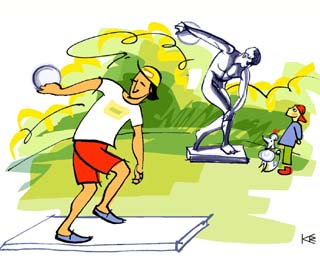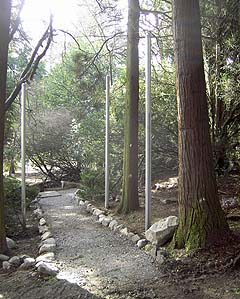
Surveys
DJC.COM
April 22, 2004
Art meets Frisbees in north Seattle park
Charles Anderson Landscape Architecture

Image by Kathryn Radke
Artist Kathryn Radke’s vision of how a sculptor may create a piece for the artwalk. |
The Hatfields versus the McCoys. Imagine the feud: one-half of a wooded 4-acre tract of public land claimed as a disc golf course the other half claimed as a sculpture park.
Competing uses, competing desires and competing aesthetics described the situation when the Seattle Department of Neighborhoods and the Department of Parks and Recreation, with funding from the ProParks Levy, enlisted our firm to transform the site near Northgate into a unified neighborhood park.
The best strategy was to look beyond the current situation and back into the history of the site.
Almost 35 years ago, the city purchased the land, which was part of a larger parcel, with the intent of developing it as offices. A single residence, the last of several, remained occupied. The owner, as part of the purchase agreement, was allowed to continue living in her home — the Kelm House — until her death.
The neighborhood and disc golfers owe their park to Mrs. Kelm's good health and long life. She lived several years longer than expected and the city was forced to abandon its idea of redeveloping the site. Instead, the site was designated open space and, except for use by the disc golfers, largely left alone.
Through the design, the Kelm House site has transformed into the “Gathering” — an open space encircled by earthen mounds and conifers. The space is not only a place for people to gather, but also a place that gathers water.
The water is stored in an underground sand-filled cistern and slowly released downhill from the Gathering to create a new “Spring” — a lush green oasis of wetland plants. The Spring is the primary landscape feature of the “Sanctuary” — a protected meadow area.
The Gathering recalls the Kelm House while the Spring replicates the mineral springs that once dotted the neighborhood and for which the park was named.
A gravel path called “The Art Walk” gracefully meanders through the Sanctuary and the Gathering as well as other settings for temporary and permanent art installations. The park was selected for an art installation as part of the 1 Percent for Art ProParks Program.

Courtesy of Charles Anderson
Landscape Architecture
Trees at Mineral Springs Park will be protected from by 40 steel poles.
|
Pennsylvania-based artist Stacy Levy created a piece called Water Drops after visiting the site. The piece is a series of polished black granite and white marble domes sited along the Art Walk. Text at the bases of the domes describes clouds seen in the night sky.
Modifications to the disc golf course included pole and mesh scrims to keep flying discs away from people, cars, neighboring properties and trees. After years of flying discs hitting tree trunks, many trees had been badly damaged and had to be removed. Over 40 galvanized poles of varying heights were installed to protect the trunks of remaining trees and to protect the over 14,000 newly added native plants.
While the poles and scrims provide protection, they also integrate art into the course. The gridded mesh of the scrims plays with light and movement — light is reflected and views obscured when looking at the scrim obliquely but the mesh virtually disappears when looking at the scrim straight on. The poles, viewed as metallic trees create a second “forest” within the forest.
The disc golf course and the art walk intersect in the southeast corner at the main entrance of the park. Although views connect the course and the art walk in several locations, this is the sole location where the two overlap. The first and eighth tees are literally embedded into the path.
Benches and a generous path width provide a place for watching the action and contemplating art. The layout also encourages interaction between the disc golfers and the neighbors.
Throughout the process, the community members and disc golf players maintained a good sense of humor as they worked to unite their disparate uses into a great park. Early in the process, artist Kathryn Radke created several renderings using well-known sculptures that captured these juxtapositions with humor, such as Michelangelo's David throwing a disc.
The park will officially re-open this summer. It is located between North 105th and 107th streets, next to Northgate Way.
We eagerly await the day when the Hatfields and McCoys use the site simultaneously and fully expect the good humor and care that each group has shown during the design and construction of the park to continue.
We expect a big celebration with a nod to Mrs. Kelm for making this new community asset possible.
Charles Anderson is a principal of Charles Anderson Landscape Architecture. Julie Parrett, a senior associate with the firm, was project manager for Mineral Springs Park.
Other Stories:
- Gardeners go trowel to trowel in contest
- What is your landscape telling you?
- Seattle's big chance to reconnect the waterfront
- Keeping runoff out of sight, but still in mind
- Ecological restoration goes beyond trees and shrubs
- Amgen unwraps the landscape at Helix
- Landscape designers promote active lifestyles
- Low-allergen landscapes nothing to sneeze at
- The do's and don'ts of planting new trees
- Shared streets can provide open space, too
- Landscape connects rivers and cultures
Copyright ©2009 Seattle Daily Journal and DJC.COM.
Comments? Questions? Contact us.